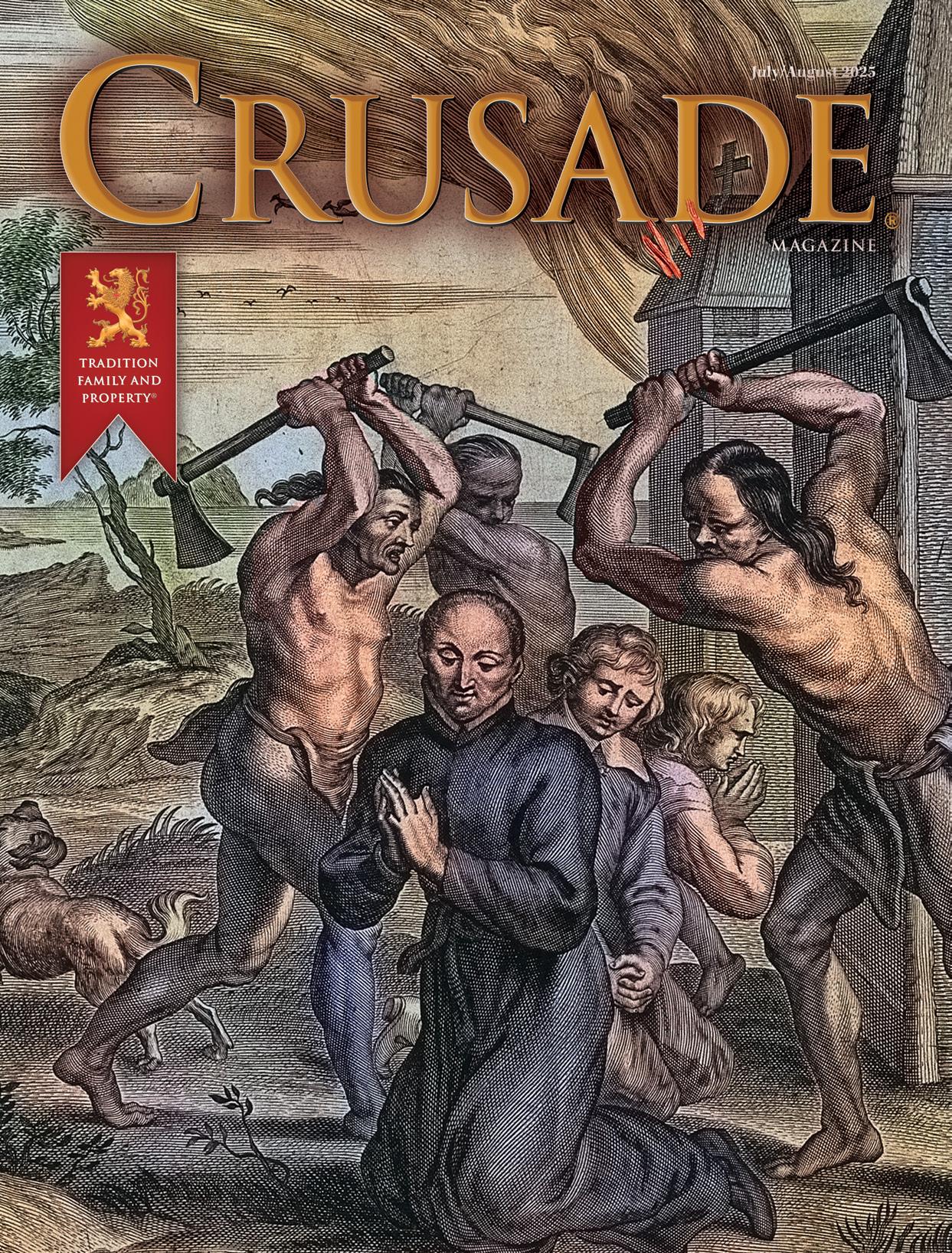

The North American Martyrs:
A Saga of Courage and Sacrifice
Modesty Is Essential to Chastity and the Salvation of Souls

Thehuman body has its beauty, and this beauty attracts us. However, Original Sin has left in man a disorder called concupiscence, which is the delight aroused in contemplating bodily beauty, particularly of the feminine body, and which can lead to temptation and sin.
That is not to say that some parts of the body are good and can be shown and others are bad and must be covered. Such a statement is absurd and was never part of Church doctrine.
All parts of the body are good, for the body is good as a whole, having been created by God. However, not all body parts are equal, and some excite the sexual appetite more than others.
Thus, exposing those parts through semi-nudity or risqué, low-cut dresses or wearing clothes so tight as to accen-
tuate one’s anatomy poses a grave risk of causing excitation, particularly in men in relation to women.
Immorality in Fashions and Destruction of the Family
Garb which fails to stress a person’s self-respect as an intelligent and free being (and, through baptism, as a child of God and a temple of the Holy Ghost), largely contributes to the present destruction of the family.
It does this by favoring temptations against purity. Such garb also accomplishes this by its vulgarity and childishness, which corrode the notion of the seriousness of life and the need for self-discipline, all of which are fundamental elements that maintain family cohesion and stability.
The struggle for the restoration of the
family by opposing abortion, contraception and homosexuality will be much more effective if done along with efforts to restore sobriety, modesty and elegance in dress.
Saint Jacinta Marto of Fatima
During a long illness, Jacinta Marto, the youngest of the Fatima seers to whom Our Lady appeared in 1917, made a startling revelation to her caregiver, Mother Godinho.
From her sickbed, she declared, “The sins that lead more souls to Hell are sins of the flesh.” Both Jacinta and her brother Francisco died a few years after the apparitions at a very young age, fulfilling Our Lady’s prophecy and promise that she would soon take them to Heaven. n

Are you ready to answer Our Lady’s call to pray for peace and save souls by becoming an October rosary rally captain?
This is your chance to stand for the Faith, pray for peace and be part of the largest rosary crusade in the world!
It’s easy to lead a public rosary rally in your community. America Needs Fatima will send you a FREE rosary rally banner and Captain’s Manual to ensure the success of your rosary rally!
We will also provide you with a 1-800 number that you can call anytime to
ask for advice or talk about your plans for praying in the public square.
Then, at noon on October 11, 2025, simply gather family, friends and neighbors to pray the rosary together in public. By doing this, you will help bring about the triumph of Our Lady’s Immaculate Heart, as she promised at Fatima.
With over 23,000 Public Square Rosary Rallies nationwide, we will send a powerful message and draw down God’s grace upon America. n
With their vibrant colors and modest lengths, these dresses will enhance the self-respect of the women who choose to wear them.
Crusade Magazine is a publication of The American Society for the Defense of Tradition, Family and Property (TFP). Direct all requests and inquiries to: Crusade Magazine, P.O. Box 341, Hanover, PA 17331 or email to: crusade@ TFP.org. Web: www.TFP.org, Tel.: (888) 317-5571. © 2025 by The Foundation for a Christian Civilization, Inc. This publication may include images from iStockphoto™ and Dreamstime™ which are protected by copyright laws of the U.S. and elsewhere. ISSN 1096-3782 LCCN 98-641433 M-196 (HF2507)
Crusade
Editor: Michael Gorre
Associate Editor: C. Michael Drake
Contributing Editors: James Bascom, Ben Broussard, Vincent Gorre, Stacie Hiserman, John Horvat II, Tonia Long, Robert Nunez, Gustavo Solimeo, Luiz Solimeo, Rex Teodosio, Renato Vasconcelos

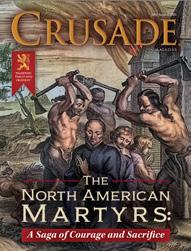



The American TFP The American Society for the Defense of Tradition, Family and Property (TFP) is an organization of lay Catholic Americans concerned about the moral crisis shaking the remnants of Christian civilization. Its earliest origins date back to January 1971, when the first TFP members started to group around the publication Crusade for a Christian Civilization. It is a civic, cultural and nonpartisan organization which, inspired by the traditional teachings of the Supreme Magisterium of the Roman Catholic Church, works in a legal and peaceful manner in the realm of ideas to defend and promote the principles of private ownership, family and perennial Christian values with their twofold function: individual and social. The TFP’s words and efforts have always been faithfully at the service of Christian civilization. The first TFP was founded in Brazil by the famous intellectual and Catholic leader Prof. Plinio Corrêa de Oliveira in 1960. His work inspired the formation of other autonomous TFP sister organizations across the globe, thus constituting the world’s largest anticommunist and antisocialist network of Catholic inspiration.

Breaking Down the Controversy: The State of Washington vs. the Seal of Confession

A Contrast of Two Laws
“Let the priest absolutely beware that he does not by word or sign or by any manner whatever in any way betray the sinner. . . . For in the tribunal whoever shall dare to reveal a sin disclosed to him of penance we decree that he shall be not only deposed from the priestly office but that he shall also be sent into the confinement of a monastery to do perpetual penance.”
That quotation was composed in 1215 as Canon 21 of the Fourth Lateran Council. The translation is from The Catholic Encyclopedia 1 Compare it with the following language from a law recently signed by the Governor of the State of Washington, Bob Ferguson, after passing the State Senate 28-20 and the State House 64-31.
“When any member of the clergy . . . has reasonable cause to believe that a child has suffered abuse or neglect, he or she shall report such incident, or cause a report to be made, to the proper law enforcement agency. . . .”

Unreasonable Action
There is no question that hearing such information during the Sacrament of Penance constitutes, in the mind of the State, “reasonable cause.”
When he signed the bill, Governor Ferguson, who professes a Catholic faith, made his position very plain. “Protecting our kids, first, is the most
important thing. This bill protects Washingtonians from abuse and harm.” He then attempted a weak defense. “My uncle was a Jesuit priest for many years, [I’ve] been to confession myself—and so I’m very familiar with that. I felt this was important legislation and protecting kids is first priority.”
The bill’s primary sponsor, Senator Noel Frame, echoed those words: “You never put somebody’s conscience above the protection of a child.”
“Let the priest absolutely beware that he does not by word or sign or by any manner whatever in any way betray the sinner. . .”
The Bishops Speak Clearly
In response, the Archbishop of Seattle, The Most Reverend Paul D. Etienne, struck a note of assurance for the people of Washington. He related his agreement with the goal of preventing child abuse and listed the steps that the Archdiocese has taken to fight it.
However, the Archbishop also clarified the Church’s ancient position in light of the State’s onslaught on the Church. “[T]he State of Washington is specifically targeting religious conduct by inserting the government into the Catholic tradition, namely, the highly defined ritual of the Sacrament of Reconciliation.”
The Archbishop then concluded, “Once the State asserts the right to dictate religious practices and coerce information obtained within this sacrament—privileged communication—where is the line drawn between Church and State? What else may the State now demand the right to know? Which other religious practices will it try to legislate? Why
B y e dwin B enson
© Christopher Bellette Dreamstime.com
is this privileged communication between priest/ penitent the only one singled out? Why not attorney/client? Doctor/patient? Spouses?”
Bishop Thomas Daly of Spokane spoke even more plainly than his associate. “I want to assure you that your shepherds, bishop and priests, are committed to keeping the Seal of Confession— even to the point of going to jail. The Sacrament of Penance is sacred and will remain that way in the Diocese of Spokane.”
The True Relationship Between Church and State
This struggle goes far beyond protecting children but has massive consequences for the relationship between Church and State.
Both Church and State are considered to be “perfect societies.” That does not mean that either can create that impossible condition often called utopia. It means that each one has as its end the good of men, which is full and supreme in its order, and possesses the sufficient means, either in reality or by right, for obtaining its end. The State has powers based upon natural law and is responsible for temporal happiness. On the other hand, the Church derives its powers from Christ and is responsible for eternal happiness. In an ideal world, both would work together while each understands that the other has powers and responsibilities that it does not.
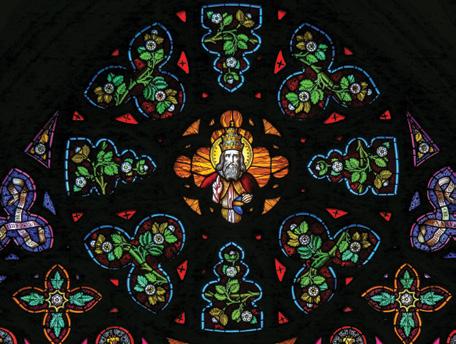
The new Washington State law would blur this relationship in many ways. First, it would limit the Church’s power to absolve sin by giving the penitent a reason not to make a full and complete confession to the priest, who in this case acts as persona Christi. Second, it forces the Church to act as an investigative arm of the State, subordinating the Church’s power to the State’s interests.
Such subordination has been a goal of radicals ever since the Protestant Revolution of the six-
teenth century. Through the generations, there have been many attempts to usurp the Church’s rightful God-given authority. Unfortunately, the State has often prevailed through its power of confiscation, imprisonment and, ultimately, execution. Therefore, the Church must always be watchful of such attempts. Resistance to the State in support of the Church’s prerogatives is often considered to be a sign of heroic virtue.
Restoring the Right Relationship
In that light, the American Society for the Defense of Tradition, Family and Property (TFP) solemnly protests the new law. Its petition to Governor Ferguson was as plain as the Governor’s words to the Church were feeble.
“You may have noticed that state legislators are using the protection of our children as an excuse to attack the Church. But you and I see their game. We know the ‘Seal of Confession vs. safety of children’ is a false dilemma.
“State legislators pretend to protect our children by pillaging our Church. They propose to save our children by stealing our confessional . . . which is a way to harm you and me and every Catholic in America.”
The Petition
Signers of our petition have a clear message for the Governor:
“Since there is absolutely no evidence that reporting sins revealed to a priest in confession would protect children, the State has no need or right to break the Seal of Confession, a sacred sacrament of the Catholic Church.
“That is why I protest your passing of SB5375, which removes the priest-penitent privilege in the Sacrament of Confession. You cannot tamper with the Seal of Confession, nor can you make the Catholic Church a ward of the State. Repeal SB5375 immediately.” n
Notes
1. The Catholic Encyclopedia , “The Law of the Seal of Confession,” 1912. Catholic Online, https://www.catholic.org/ encyclopedia/view.php?id=3245.

Please sign TFP’s online petition to defend the Sacrament of Confession. Don't forget to ask your friends and family members to do the same!
The Church's spiritual power comes from God; therefore, it should never be subordinated to the State's interests.

What Does Saint Thomas Say About Immigration?
Whendiscussing immigration, it is almost automatically assumed that the Church’s position is one of unconditional charity toward those who enter the nation, legally or illegally. However, is this the case? What does the Bible say about immigration? What do Church doctors and theologians say? Above all, what does the greatest of doctors, Saint Thomas Aquinas, say about immigration? Does his opinion offer some insights into the burning issues now shaking the nation and blurring the national borders?
Immigration is a modern problem, and so some might think that the medieval Saint Thomas would have no opinion about it. And yet, he does. One has only to look in his masterpiece, the Summa Theologica, in the First Part of the Second Part, question 105, article 3 (I-II, Q. 105, Art. 3). There, one finds his analysis based on biblical insights that can add to the national debate. They are entirely applicable to the present.

Saint Thomas: “Man’s relations with foreigners are twofold: peaceful, and hostile: and in directing both kinds of relation the Law contained suitable precepts.”
Commentary: In making this affirmation, Saint Thomas affirms that not all immigrants are equal. Every nation has the right to decide which immigrants are beneficial, that is, “peaceful,” to the common good. As a matter of self-defense, the State can reject those criminal elements, traitors, enemies and others who it deems harmful or “hostile” to its citizens.
The second thing he affirms is that the manner of dealing with immigration is determined by law in the cases of both beneficial and “hostile” immigration. The State has the right and duty to apply its law.
Saint Thomas: “For the Jews were offered three opportunities of peaceful relations with foreigners. First, when foreigners passed through their land as travelers. Secondly, when they came to dwell in their land as newcomers. And in both these respects the Law made kind provision in its precepts: for it is written (Exod. 22:21): ‘Thou shalt not molest a stranger [advenam]’; and again (Exod. 22:9): ‘Thou shalt not molest a stranger [peregrino].’”
Commentary: Here, Saint Thomas acknowledges the fact that others will
These veterans attending a naturalization ceremony in Newport, Va., know that it takes time to understand the issues affecting a nation.

want to come to visit or even stay in the land for some time. Such foreigners deserve to be treated with charity, respect and courtesy, which is due to any human of good will. In these cases, the law can and should protect foreigners from being badly treated or molested.
Saint Thomas: “Thirdly, when any foreigners wished to be admitted entirely to their fellowship and mode of worship. With regard to these a certain order was observed. For they were not at once admitted to citizenship: just as it was law with some nations that no one was deemed a citizen except after two or three generations, as the Philosopher says (Polit. iii, 1).”
Commentary: Saint Thomas recognizes that there will be those who will want to stay and become citizens of the lands they visit. However, he sets as the first condition for acceptance a desire to integrate fully into what would today be considered the culture and life of the nation.
A second condition is that the granting of citizenship would not be immediate. The integration process takes time. People need to adapt themselves to the nation. He quotes the philosopher Aristotle as saying this process was once deemed to take two or three generations. Saint Thomas himself does not give a time frame for this integration, but he does admit that it can take a long time.
Saint Thomas: “The reason for this was that if foreigners were allowed
Saint Thomas Aquinas, the Angelic Doctor, is one of Western tradition's most influential philosophers and theologians.

to meddle with the affairs of a nation as soon as they settled down in its midst, many dangers might occur, since the foreigners not yet having the common good firmly at heart might attempt something hurtful to the people.”
Commentary: The common sense of Saint Thomas is certainly not politically correct, but it is logical. The theologian notes that living in a nation is a complex thing. It takes time to know the issues affecting the nation. Those familiar with the long history of their nation are in the best position to make the long-term decisions about its future. It is harmful and unjust to put the future of a place in the hands of those recently arrived, who, although through no fault of their own, have little idea of what is happening or has happened in the nation. Such a policy could lead to the destruction of the nation.
As an illustration of this point, Saint Thomas later notes that the Jewish people did not treat all nations equally since those nations closer to them were more quickly integrated into the population than those who were not as close. Some hostile peoples were not to be admitted at all into full fellowship due to their enmity toward the Jewish people.
Saint Thomas: “Nevertheless it was possible by dispensation for a man to be admitted to citizenship on account of some act of virtue: thus it is related (Judith 14:6) that Achior, the captain of the children of Ammon, ‘was joined to the people of Israel, with all the succession of his kindred.’”
Commentary: That is to say, the rules were not rigid. There were exceptions that were granted based on the circumstances. However, such exceptions were not arbitrary but always had in mind the common good. The example of Achior describes the citizenship bestowed upon the captain and his children for the good services rendered to the nation.
gation. The immigrant should not only desire to assume the benefits but also the responsibilities of joining into the full fellowship of the nation. By becoming a citizen, a person becomes part of a broad family over the long term and not a shareholder in a joint stock company seeking only short-term self-interest.
Secondly, Saint Thomas teaches that immigration must have in mind the common good; it cannot destroy or overwhelm a nation.
This explains why so many Americans experience uneasiness caused by massive and disproportional immigration. Such policy artificially introduces a situation that destroys common points of unity and overwhelms the ability of a society to absorb new elements organically into a unified culture. The common good is no longer considered.
These are some of the thoughts of Saint Thomas Aquinas on the matter of immigration based on biblical principles. It is clear that immigration must have two things in mind: the first is the nation’s unity; and the second is the common good.
Immigration should have as its goal integration, not disintegration or segre-
The nation must practice justice and charity towards all, including foreigners, but it must above all safeguard the common good and its unity, without which no country can long endure.
A proportional immigration has always been a healthy development in a society since it injects new life and qualities into a social body. But when it loses that proportion and undermines the purpose of the State, it threatens the well-being of the nation.
When this happens, the nation would do well to follow the advice of Saint Thomas Aquinas and biblical principles. The nation must practice justice and charity towards all, including foreigners, but it must, above all, safeguard the common good and its unity, without which no country can long endure. n
New U.S. citizens swearing allegiance to the Flag of the United States as part of a naturalization ceremony.
and Heroes
How the Carmelites of Compiègne Heroically Won Heaven
The sixteen Carmelites of Compiègne, who were guillotined in 1794 during the French Revolution, have their feast day on July 17.
The Church often, but not always, celebrates the feasts of martyrs on the day they died because it is the most glorious day of their lives. They were born to eternal life on this day.
Sister Marie de L’Incarnation, the biographer of the holy Martyrs, wrote about one of the Carmelites, Sister Marie Henriette de la Providence, who was thirty-four years old at the time of her martyrdom:
“Her unusual beauty made her run into dangers that alarmed her modesty. She wanted to renounce the world at once to put herself in safety. When she appeared before the [Revolutionary] court, she distinguished herself, without pretension, by an attitude of truly heroic firmness.
“Having heard the public prosecutor call them fanatics and counter-revolutionaries, she claimed not to know the meaning of these words and asked him to please explain them. When the nuns entered the courtroom, Sister Henriette deliberately questioned him:
“‘Could you, citizen, tell us what you mean by that word fanatic.’
therefore, to answer us and tell us what you understand by the word fanatic.’
“‘I understand it,’ replied Antoine-Quentin Fouquier-Tinville, the public prosecutor of the Revolutionary Tribunal during the Reign of Terror, ‘as your attachment to your foolish religious practices.’
“After thanking him, Sister Henriette turned to the Mother Prioress and said: ‘My dear Mother, my sisters, you have just heard the accuser declare that we are going to be put to death because of our attachment to our holy religion. We all desire this testimony and venerate it. Let immortal thanks be given to Him who first opened the way to Calvary for us. Oh, what happiness to die for our God!’”
According to another version of the dialogue, Fouquier-Tinville responded: “Since you want to know, it is because of your attachment to your religion and the king.” To which Sister Henriette is said to have responded, “Thank you, citizen, for this happy explanation.”
"Oh, what happiness to die for our God!"
exclaimed Sister Henriette after being dubbed a "fanatic" by the public prosecutor.
“The irritated judge answered by vomiting a torrent of insults upon her and her companions. Our saint, not a little disconcerted, said to him, with dignity and firmness, ‘Citizen, it is your duty to honor a convict’s right to ask a question. I ask you,
Turning to her companions, she said, “My dear Mother, my sisters: let us exult and rejoice in the joy of the Lord because we die for the sake of our holy religion, our faith, our confidence in the Holy Roman Catholic Church.”
Sister Henriette was the last nun to die at the scaffold before the prioress. She encouraged her companions until the end. When a charitable person offered water to one nun, Sister Henriette stopped her as she

Prophets, Martyrs, Saints

was about to accept, saying: “In Heaven, in Heaven, my sister, we shall take long gulps.”
Commentary on the Account
Sister Henriette asked the reason for their deaths so that the public prosecutor might give testimony for the record that they were to be martyrs. His answer consoled them because it confirmed they were condemned because of the Catholic Church and, thus, were to be martyrs. She was so happy with the news that she immediately communicated it to the Mother Superior and the other sisters.
There are two versions of the story, one of which is a little more counter-revolutionary than the other. One version says that Fouquier-Tinville did not mention the king but only God. Another version claims that he said they also died because of the king. This latter version is much more likely because the prosecutor killed everybody because of a double allegiance to God and the king.
However, attributing their deaths to the king runs counter to Pope Leo XIII’s famous Ralliement policy, which called upon Frenchmen to support the Republic. Thus, later versions excluded the king from the course of events and only mentioned God Our Lord as the most essential element.
The episode of the glass of water is also very beautiful. One sister was very thirsty and naturally shaken due to the nervous trauma of being at death’s door—a tragic and violent death. She was accepting a glass of water that someone offered her when Sister Henriette thought: If she made a small sacrifice, it would be one more pearl for the glory of God. Why drink water and have this little consolation when she can offer one more little sacrifice? So she conceived this magnificent expression: “In
Heaven, my sister, we will drink big gulps of water.”
Indeed, Our Lord promised fountains of living water to His elect, which consist of the contemplation of God face-to-face. In Heaven, happiness is perpetual.
The other sister agreed. When she received the crown of martyrdom, the crown had an extra star for all eternity because of that small sacrifice.
This sister’s account contrasts with the famous fictional character of Blanche de la Force found in the novel Song at the Scaffold, by Gertrude von Le Fort. This story imagined a weak Carmelite of the convent who was terrified by merely hearing about death and ran away. When she heard that her Carmelite sisters were going to the gallows, she went to the site to watch. As the joyful sisters went to death singing “Veni Creator Spiritus,” she came out of the crowd and entered the line. Singing the hymn, she went up to the gallows and died.
God works wonders in different ways according to each soul. For some, He chooses to give graces for the immediate act. For others, He provides graces that prepare them over time.
By contemplating sanctity here on earth, it is easier to imagine the beauty of Heaven.
Thus, He worked wonders in the soul of Sister Henriette, who is the opposite of Blanche de la Force. She saw death from afar and faced it joyfully. She encountered her accuser, made him state they were martyrs and helped the other nuns die well. The only reason she died before the prioress is that the hierarchical order called for the prioress to die last. The captain is the last to leave the ship. God guides and molds people’s souls like this brave nun’s in many ways.
God is infinitely beautiful in both His unity and variety. This way of acting allows Him to form such diverse saints and different spiritual schools within the Holy Catholic Church. All of these ways reflect God’s beauty and let the faithful understand something of Our Lord’s infinite beauty through them.
By contemplating sanctity here on earth, it is easier to imagine the beauty of Heaven. Souls in Heaven contemplate God face-to-face. However, they can also come to know God through the immeasurable beauty of all the saints and angels there. Above all, those in Heaven will know Our Lady, who ineffably surpasses the spiritual beauty of all the angels and saints. n
The preceding article is taken from an informal lecture Professor Plinio
de Oliveira gave on July 23, 1969. It has been translated and adapted for publication without his revision. —Ed.
Corrêa
Saint Teresa of Ávila offers the palm of martyrdom to sixteen of her daughters, the Carmelites of Compiègne, on July 17, 1794.


The feast day of the North American Martyrs is celebrated on September 26 in Canada and October 19 in the United States.
The North American Martyrs:
A Saga of Courage and Sacrifice
The word “martyr” comes from a Greek word meaning “witness.” By definition, a martyr is somebody who suffers death for the Catholic Faith as a witness to Christ.
A group of saints that fits this category so well is the North American Martyrs, who gave witness to the Faith by the shedding of their blood for the conversion of the Native Americans.
Who Were They?
Eight French Jesuits traveled to the New World— what is now Canada and New York—to convert the natives. After enduring years of suffering and hardship, they paid the ultimate price by willingly shedding their blood for Christ.
There were six Jesuit priests: Fathers Isaac Jogues,
Jean de Brébeuf, Noël Chabanel, Charles Garnier, Gabriel Lalemant and Antoine Daniel, along with two lay brothers: René Goupil and Jean de Lalande.
The missionaries studied at the most prestigious universities in France, acquiring a thorough understanding of the sacred and natural sciences. They knew how to chart maps, make astronomical and meteorological observations and were able to provide detailed observations of the fauna and flora they discovered on their travels.
Canada at the Turn of the Sixteenth Century
At the beginning of the 1600s, New France was a vast and untamed wilderness. This immense land was populated by thousands of natives whose whole
Saint Jean de Brébeuf and Joseph Chiwatenhwa, one of the first Huron converts and a martyr himself, overlooking the Huron settlement of Saint Louis (stained glass window in the Martyrs’ Shrine, Midland, Ontario).
existence seemed to revolve around warfare and who delighted in torture and bloodshed.
By 1608, a French settlement had been established at Québec. Soon afterward, the first Jesuit missionaries began arriving to minister to the colonists and natives.
When the Jesuits arrived in New France, a bloody religious conflict known as the Thirty Years War (1618–1648) was raging back home. During this period, England and France were often engaged in warfare, which also reverberated in North America. The two most prominent Indian confederacies often joined in this conflict, with the Hurons choosing the side of France, and their sworn enemies, the Iroquois, preferring to fight for England.
The rivalry between these two powerful Indian nations caused the Jesuits great suffering and nearly led to the extermination of the Huron Nation.
Epic Mission: The Spiritual Conquest of a Continent
The huge area of land known as Huronia was destined to be the first mission territory of the Jesuits. Stretching from the north shores of present-day Lake Ontario and northwards to Georgian Bay, this vast tract of land was home to the Huron Nation.
The Jesuits intended to conquer the North American continent for Christ. But, due to a shortage of missionaries, they were compelled to limit their activities to New France.
In their great zeal, the missionaries made a plan to plant the cross in every Indian village and establish missions among every native tribe. Indeed, the Jesuits did everything in their power to baptize the natives and bring them into the fold of the one true Church.
Saint Charles Garnier
A typical example of this is Saint Charles Garnier, who, with his dying breath, tried to save the soul of another man. Born in Paris, France, in 1606, Charles Garnier’s entire life was characterized by an indefatigable zeal for souls. He entered the Society of Jesus and, in 1635, was ordained a priest. Shortly after, he began earnestly requesting that his superiors send him to the Canadian missions. He set sail for New France in 1636, and before the ship made landfall, Father Garnier brought several of the ship’s fallen away Catholics back to the Faith.
Upon his arrival at the missions, Father Gar-
In their great zeal, the missionaries intended to plant the cross in every Indian village and establish missions among every native tribe.
nier set to work with his usual energy. He did not hesitate to travel thirty or forty miles on a blazing summer’s day to baptize a dying native. He would even go so far as to carry a sick person on his back for six miles or more just to be able to baptize him.
In December of 1649, Father Garnier was ministering to a community of Petun natives in the town of Etarita when the Iroquois attacked the village. The Iroquois braves streamed into the village and set fire to the cabins, cutting down everyone in their path.
Father Garnier rushed into the burning cabins, trying to save as many souls as possible, but he was soon surrounded by the Iroquois and fell, pierced by two bullets. Amazingly, he was still alive, and seeing a wounded native lying nearby, he crawled towards him in order to provide spiritual assistance. At that moment, an Iroquois brave pounced upon him and killed him with a tomahawk.
Father Garnier’s extraordinary life is typical of all the other Canadian Martyrs who lived out Our Lord’s words, “Go and make disciples of all nations, baptizing them in the name of the Father and of the Son and of the Holy Spirit” (Matt. 28:19).
Apostolate Among the Natives
In the field of apostolate, the Jesuits proved to be masters, instructing the natives in the Catholic Faith through many ingenious means, such as putting the truths of the Catholic Faith into songs for the young Hurons. In fact, the missionaries placed great emphasis on this apostolate with the young natives.
Saint Antoine Daniel was especially devoted to this youth apostolate. A native of Dieppe in Normandy, France, Antoine Daniel was ordained a priest for the Society of Jesus in 1630. Two years later, he sailed to the New World to take up missionary activities on Cape Breton Island, Nova Scotia.
Later, he did work on the mainland in a village called Ihonatiria. He made inroads in his work with the native children who, although unruly and irascible, were won over by Father Daniel’s

kind ways. The priest had such great success that before long, he taught them to sing the Our Father, the Hail Mary and the Ten Commandments. He got a choir together that would sing at the Masses and, as a result, attracted a great number of curious adult Hurons to the religious ceremonies.
Eventually, Father Daniel came to Québec, where he established the first college for boys in North America. He ended up at the Huron village of Teanaostaye, where, on July 4, 1648, an Iroquois war party appeared at the town gates. Father Daniel rushed to the chapel, where the terrified inhabitants were gathering. He gave them general absolution and, taking his handkerchief, dipped it in holy water, baptizing all the catechumens who were present. His next move was totally unexpected. This courageous priest left the chapel and, walking toward the bloodthirsty Iroquois, commanded them not to enter the chapel. The astonishment of the Iroquois warriors quickly gave way to rage, and they charged at him.
Father Antoine Daniel was hit by a bullet and killed instantly. Taking his body, the Iroquois tossed it into the chapel, which they set ablaze. Thus died a great apostle described by his Jesuit superior as “a man of great courage and endurance,” a priest who “burned with a zeal for God more intense than any flame that consumed his body.”
“I have a strong desire to suffer for Jesus.”
Shortly before his martyrdom, Saint Jean de Brébeuf declared: “I have a strong desire to suffer for Jesus Christ,” a devotion shared by his fellow missionaries. This extraordinary willingness to suffer for a higher good encapsulates the spirit of these brave men who acted as imitators of Christ, ready to die for the sake of the Cross.
Saint Isaac Jogues is another salient example. Born in Orléans to a distinguished family, he entered the Jesuit novitiate at Rouen, and when asked what he wished for, he answered, “Ethiopia and martyrdom.”
After his ordination to the priesthood, he arrived in New France in 1636 to take up the arduous life of a missionary. Eventually, Father Jogues was captured and tortured by a band of Iroquois. His hands
were horribly mutilated, and his thumb was sawn off. He remained in captivity for thirteen months and underwent many terrible hardships. At last, he escaped and, after recuperating in France, eagerly returned to the mission field.
In 1646, Father Jogues, along with his lay brother, Jean de Lalande, returned to the place of his captivity at Ossernenon (Auriesville, N.Y.). The object of their trip was to negotiate a peace treaty between the Hurons and Iroquois. Shortly before his departure, in a letter to a fellow Jesuit, Father Jogues writes, “In very truth it will be well with me, it will be a happiness for me, if God be pleased to complete the sacrifice there where He began it.”
God heard this humble prayer when the Iroquois, in a sudden act of treachery, captured and killed Father Jogues and his companion, Jean de Lalande, with tomahawks in October of 1646.
Not all the North American Martyrs were Jesuits. Jean de Lalande and René Goupil were both lay brothers.
René arrived in New France in 1640 to serve as an assistant in the mission. He was the youngest martyr, surrendering his life to God at the age of thirty-four. René Goupil was tomahawked by an Iroquois war party because he taught a native boy how to make the Sign of the Cross, and died heroically uttering the words, “Jesus, Jesus, Jesus.”
“The blood of the martyrs is the seed of the Church”
Early Christian author and apologist Tertullian, in his work Apologeticus, notes that “the blood of the martyrs is the seed of the Church.”
In their zeal to convert souls, the Jesuit Martyrs were willing to shed their blood in order that the seed of the Gospel would bear great fruit.
Shortly before their deaths, the two Jesuit priests, Jean de Brébeuf and Gabriel Lalemant,

The Blackrobes, Fathers Lalemant and Brébeuf, endured torture and death, thus perfectly fulfilling their vocations as imitators of Christ.
Saint Jean de Brébeuf endured horrific tortures with remarkable courage. His tormentors drank his blood and ate his heart in their attempt to "acquire" his bravery.
while working together in the same mission, decided to offer their lives to God as a way to further the missions in Canada.
God accepted their offering. In March of 1649, Fathers Brébeuf and Lalemant were visiting the Huron village of St. Louis when a large band of Iroquois warriors descended on the village, killing most of the defenders and taking the two priests captive to torture them.
They chose Father Brébeuf, along with several Huron Christians, as the first victims and commenced their brutalities by breaking the bones of the Jesuit’s hands and tearing out his fingernails.
Next, he was tied to a post, and in an effort to break his indomitable spirit, they burned his body with torches. A renegade Huron came forward and, in mockery of baptism, poured boiling water over him. When Father Brébeuf did not cry but remained calm, his tormentors were greatly infuriated. Taking knives, they cut strips of flesh from his legs and arms and, after roasting them, ate them before his eyes.
In their zeal to convert souls, the Jesuit Martyrs were willing to shed their blood in order that the seed of the Gospel would bear great fruit.
Seeing the heroic Jesuit’s strength begin to fail, the Iroquois scalped him, and one of them cut out his heart and ate it while others drank his blood, hoping to “acquire” some of his remarkable courage.
All through the night Father Brébeuf’s companion, Father Gabriel Lalemant, suffered unspeakable tortures. In the morning, Father Lalemant’s agony came to an end with the blow of a tomahawk, and this Jesuit missionary, frail in body but strong in spirit, went to his eternal reward.
By shedding their blood for the cause of Christ, the Martyrs laid the foundation for the Catholic Faith throughout North America.
Selfless Devotion, Love and Obedience to Holy Mother Church
What led these great men to become Jesuits, travel to New France as missionaries, embrace every kind of privation and hardship and finally die a gruesome death?
Only a sublime motive is capable of producing such a high degree of devotion and heroism. Only a profound union with the Cross of Christ can inspire such noble and selfless sacrifice. These eight martyrs were true friends of the Cross. They

demonstrated a burning love for the One, Holy, Catholic and Apostolic Church, founded by Our Lord Jesus Christ for the sanctification of souls.
Just as the North American Martyrs embraced their crosses and conquered Heaven for all eternity, Professor Plinio Corrêa de Oliveira bids every Catholic to accept and love their own crosses:
“If we misunderstand the role of the cross, refuse to love it and fail to walk along our own Via Dolorosa, we will shirk Providence’s designs for us. We will be unable, with our dying breaths, to repeat the sublime exclamation of Saint Paul: ‘I have fought a good fight, I have finished my course, I have kept the faith. As for the rest, there is laid up for me a crown of justice, which the Lord the just judge will render to me in that day”’ (2 Tim. 4:7–8). n
Sources and recommended reading:
1. Francis X. Talbot, Saint Among Savages: The Life of Saint Isaac Jogues (Whitefish, MT: Kessinger Publishing, 2011).
2. John A. O’Brien, Saints of the American Wilderness: The Brave Lives and Holy Deaths of the Eight North American Martyrs (Manchester, NH: Sophia Institute Press, 2004).
3. “The North American Martyrs,” Catholic News Agency, https://www.catholicnewsagency.com/saint/the-northamerican-martyrs-25.
North
American Martyrs’ Shrines to visit:

In Canada: Martyrs’ Shrine 16163 Highway 12 West Midland, Ontario, Canada L4R 4K6
In the United States: National Shrine of the North American Martyrs (also known as Our Lady of Martyrs Shrine) 136 Shrine Rd #2 Fultonville, NY 12072
The Martyrs Shrine in Midland, Ontario, was erected seven miles from the site of the martyrdom of Fathers Jean de Brébeuf and Gabriel Lalemant.
Corrêa de Oliveira
The Mobile Immobility of Chaos
Ifthere is one common denominator in the public and private lives of people today, it is chaos. Chaotic perspectives seem to be multiplying as we head down the road to chaos, and no one really knows where it leads.
The enigmatic forces of chaos produce explosions and eruptions that give the impression that the world will collapse. Foolish optimists—excuse the redundancy—do not greatly fear this chaos because they think that eventually “everything will go back to square one.” Those who consider themselves farsighted become alarmed, thinking the world will soon “turn upside down.” However, both are mistaken since what ends up dominating is a situation where “plus ça change, plus c’est la même chose”—the more things change, the more they stay the same.
In the face of multiplying catastrophes, moral decay and material devastation, humanity languishes and issues the lament: “Everyone must submit to brokenness as the rule of life. Everything is broken; nothing has any meaning!”
Indeed, we witness and suffer a chaotic process that moves yet is immobile. We see disagreements break out here and there. Situations become so tense and critical that it seems a world war could suddenly break out anywhere. However, in this whirlwind of chaos, everything ends up immobile.
Thus, an increasing number of countries plunge into this fixed immobility amid continuous mobility.
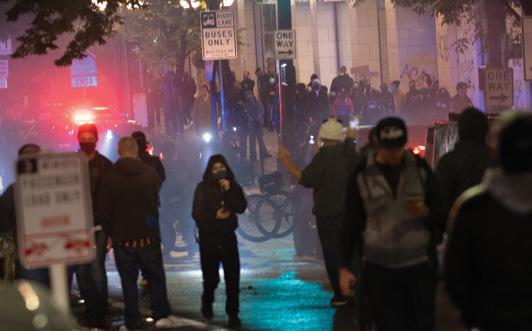
Situations neither improve nor worsen but create great drama.
This tragedy is a kind of psycho-social AIDS spreading throughout the world. It is a disease that does not kill but weakens everything healthy and organic within nations.
In the face of multiplying catastrophes, moral decay and material devastation, humanity languishes and issues the lament: “Everyone must submit to brokenness as the rule of life. Everything is broken; nothing has any meaning!”
The underlying message seems to be: “Get used to it and understand that nothing has any reason to exist anymore! Human reason is dead, and nothing reasonable will happen ever again! This may not be affirmed explicitly, but world events will increasingly appear absurd and unreasonable. Everyone should get used to the idea that absurdity rules the world!”
Thus comes the conclusion: “Begone, reason! Human thought, be still! Let humanity reflect no more but rather be carried away by events like animals!”
"From the depths of the abyss. . . this message. . . appears like a song at once sinister and attractive. . . that comes from. . . the father of evil, error and lies. . . shouting his. . . 'Non serviam'—I will not serve!"
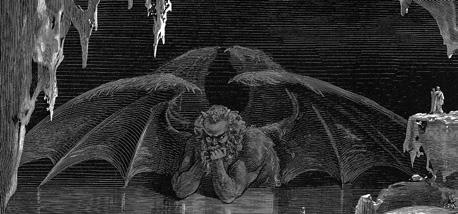
From the depths of this abyss, astute Catholics can discern a deceptive glimmer in this message. It appears like a song at once sinister and attractive, soothing and delirious that comes from that abject being who is the personification of irrationality, absurdity and the foolish, hate-filled revolt against the Almighty: the devil. The father of evil, error and lies groans and gasps in despair, shouting his eternal and nefarious cry of revolt: “Non serviam”—I will not serve!
These are perspectives theologians can and should discuss—the few but genuine theologians who still believe in the existence of the devil and Hell. n
An "explosion" occurred in Seattle, Wash., in the summer of 2020, when all authority was challenged and usurped by a chaotic backlash.
Plinio

America Needs Fatima ®
July/August 2025 PROGRESS REPORT

From the Desk of Robert Ritchie
Dear Soldier of Our Lady,
Schools, libraries and parishes used to be the safest places for our children. They were places where we knew they would receive a moral education and be able to grow in their faith. But no longer!
Today, our children face a grave threat across the country from those who want to push immoral curricula, books and learning tools in our institutions of learning—and even in our parishes. The advancement of the “woke” LGBTQ agenda is everywhere.
These areas, once places of learning, are now overcome by disturbing and explicit books and teachings that promote pornography, homosexuality, gender ideology and pro-abortion propaganda.
That’s why I hope you’ll join me in September for a special campaign in reparation for and protest against those who are pushing these immoral and blasphemous LGBTQ agendas at our schools, libraries and parishes.
Our Lady is calling you to join her army, to take up your rosary and give public witness that you oppose the deliberate attack on the innocence of our children. Join us and lead a rosary rally in September to pray for an end to these immoral teachings and agendas that ultimately are attacks upon God’s law and order.
Sign up to host a rosary rally on any Saturday in September at noon your local time. It’s easy to do: just gather your friends, family and community members in a public place and lead them in prayer. To sign up, email Protest@TFP.org.
Our Lady will reward you for protecting the little ones who mean so much to her!
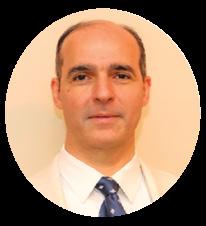
Sincerely, In Jesus and Mary,
Robert E. Ritchie, Executive Director

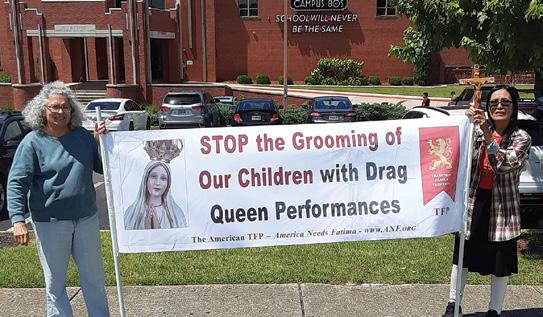
Alabama Rally Opposes Drag Queen Events
Gloria, a rally captain, and her friends gathered to pray the rosary in reparation for Drag Queen events being held at Straight to Ale brewery in Huntsville, Ala.
Gloria said it was important to her to host the rally because she feels those with LGBTQ ideologies are trying to groom innocent children.
She faced some opposition during the rally, but also experienced positive reactions: Two people came up and wanted to take a picture with her banner. Another young man thanked the group for being there to pray, and a policeman told her she had a right to be there and that she should move closer to the street so others could see her.
Gloria said she was grateful to be asked to host the rally: “We stayed for three hours. It was really important for us to pray for the protection of children from all the evil ideologies. I pray these bad experiments will be stopped.”
Captains Organize 1,376 Rosary Rallies to Honor
Our Lady of Fatima
Enthusiastic, committed rally captains answered the call across America! Through their dedication, a total of 1,376 rosary rallies honoring Our Lady of Fatima were held during May in cities across the country.
These rallies marked the anniversary of Our Lady’s appearance in Fatima on May 13, 1917, and her request that we
pray the rosary daily to obtain peace for the world.
Although she first appeared over 100 years ago, Our Lady’s message is more important than ever. That’s why Linda, a rally captain, gathered her friends and family to pray in Magnolia, Tex.
“We had beautiful weather in Magnolia today for Mary’s rosary. Our grandson even crowned Mary! We were grateful to hold this rally to ask for her intercession and make reparation for sins that wound her Immaculate Heart,” she said.
We are thankful for all our prayer warriors who answered the call and brought together friends, family and community members to pray in public.

Creating a Legacy of Prayer in Louisiana
Our faithful prayer warriors feel such a deep connection to God and Our Lady when they host public rosary rallies that many of them return month after month to pray with their families and friends.
In Mansfield, La., Donna has been holding monthly rosary rallies at a prominent gazebo in the center of town. In addition to hosting a special rally to honor Our Lady, Donna and her dedicated group also gathered to pray in reparation for blasphemy and to protest against our children being exposed to pornographic books in libraries and schools.
Donna shared that organizing these monthly rallies has

been easy and that the group always feels a great sense of peace when honoring God and Our Lady. They hope that by praying the rosary in public, they will attract other people who believe in the power of public prayer.
Defending the Faith Against Wolves
Many TFP-ANF friends and supporters hosted a rosary rally at Sacred Heart University in Fairfield, Conn., to protest Father James Martin’s appearance to promote his new book. Father Martin’s ideologies are against the Bible, natural law, papal documents, the Fathers of the Church, the Catechism of the Catholic Church and countless saints.
Michael, who is a rally captain, said the group received a good amount of resistance, especially from female students who screamed and cursed from their cars as they drove by. One student, who professed to love the rosary, commented he was actually only there because his professor wanted students to attend the talk for extra credit.
Despite the opposition, the rallygoers were encouraged. Michael said the group was glad they held the rally. “It did not dampen our resolve and repugnance of this horrible, blasphemous event. It made even more palpable the crucifixion the Holy Catholic Church is going through in our days. It was an honor to defend Our Lord and Our Lady.”
Honoring the Sacred Heart of Jesus at 1,550 Rosary Rallies
Every year during June, we face the fight to reclaim the month for the Sacred Heart of Jesus and not accept it to “honor” homosexual pride. Our rally captains responded to this campaign in full force and organized 1,550 rosary rallies across the country.
While the rest of the country celebrated Pride events, including Pride Masses at churches, our prayer warriors stood firm in their faith to honor Jesus and His love and mercy. By holding these rallies in public, our rally captains showed their communities the importance of offering reparation for offenses against the Sacred Heart and asked the Blessed Virgin Mary to guide our nation back to God.
Selina in Cameron, La., understands how praying the rosary in public is a powerful weapon: “We had the rosary rally in front of our church, which is on a highway. Thank you and God bless you all in your wonderful work for Christ and His mother!”

Over 500 Rosary Rallies Oppose Blasphemous Film Dogma
Hundreds of faithful prayer warriors gathered in cities across the country to make reparation against the twenty-fifth-anniversary screening of the blasphemous movie Dogma.
Our rally captains came out in full force in dozens of cities to defend Our Lord against this blasphemous, deliberate attack on our Faith. As of May 12, when we closed this edition, 516 protests against the film had already been organized.
The film mocks everything that Catholics hold sacred, including God, the Church, the Mass and Mary’s virginity. The film’s many outrageous scenes include a woman known for nude videos playing the part of God and references to the Holy Sacrifice of the Mass as sexual intercourse.
Many rally participants said they were honored to make reparation to God and Our Lady through these rallies. They felt compelled to speak out through public witness in defense of our Holy Faith and resolutely stood against those who participated in the vile insults Our Lord sustained by attending the film screenings. n
Our Readers and Viewers Write
From our re Aders:
Catholics Defeat Satan in Kansas*
“My sister and I prayed the rosary along with you guys, then the rest of my family joined in prayer towards the end. My mother cast the livestream onto our big TV, and we all watched as he broke the news that a man had rescued the Host and the head Satanist was arrested for trying to enter the capital building. We were ecstatic. After we heard the news, I put up our flag of the Sacred Heart as a sign of victory and reparation. I will never forget the joy of that day when my family and I sang hymns of praise and prayed litanies at the defeat of Satan in Topeka, Kansas.” Andrea

“I’ve been looking around, but at the end, no one does what you do the way you do. Raise those standards high!”
Pierce L., Chicago, Ill.
“Thank you for the update on the protest in Topeka. The video and report were truly moving, and it’s inspiring to hear about the significant turnout of faithful Catholics who participated in such a peaceful and powerful demonstration of faith. I am deeply grateful for your efforts in organizing this important event and for the dedication of all those involved. While I was unable to be present physically, I was indeed praying for its success. Your work
in upholding religious freedom is commendable.” Vi S.
“We watched the whole time and prayed along with you all. It was wonderfully done! We are so glad to have been able to participate in this!!! Thank you for representing the Church in this public way and letting us make reparation right along with you on this windy, windy day.”
Bob and Debbie R.
ANF Apostolate
“Looking at your photo of Our Lady of Fatima got me through a time of great desolation in my life. Looking into her eyes, you know you’re not alone, and that if Our Lady is the only one who understands you, that’s enough. If you have her, you’re never alone, never misunderstood, never abandoned, never hopeless. Mighty before God, she casts a long shadow in Heaven and is worth more than a thousand human supports. She gives all glory back to God, and is in turn, ‘blessed among women.’”
Anonymous, Boston, Mass.

“I always keep your rosaries on me, an extra rosary in my car—I gave away my last extra one to a young man at church who didn’t have one and was lost as to how to get one. It seems to me that the Lord always sends me someone who needs a prayer book or a rosary. And it’s interesting that although I never know them, they always turn out to be young people.”
Estela B., Abilene, Tex.
If America Needs Fatima has touched you in a special way, please share your story by calling our friendly customer service department at (888)317-5571 or send us an email at ANF@ANF.org.
From our Viewers:
“‘Without exception, life begins at conception.’ It’s wrong to kill (period). Babies, born and unborn, are supposed to be protected and loved. Protect the little ones! A baby has a right to life, and it shouldn’t be callously discarded. Babies’ lives and rights matter.” @BrittanyWagner-b1g
“I think a lot of our Catholic schools and universities are not doing their job when it comes to Catholic teachings. It is the same here in Canada.” @gordmac896
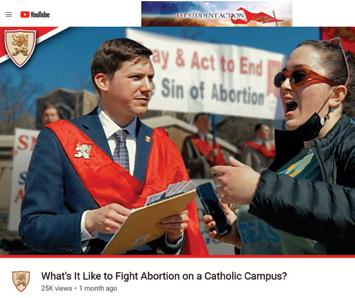
“God bless you, God-fearing gentlemen. May Saint Michael guide and guard you in this effort to distribute the truth. Peace of Christ to you all.”
@anthonyschreiner9452
“Amen, lads, thank you for doing such important work. Our nation needs to turn back to God. Praying for your health and safety. Keep up the good work!” @tinaberger485
“That lady who came back had her conscience gnawing at her to return. I’m going to guess she or someone close to her has aborted. Those who are in denial of the facts are often already hurting. Let’s pray for her.” @kateuli8481
*For more information on this event, see Crusade Magazine, May/June 2025.
A Mother’s Day to Remember
Children who love their mothers show their affection and appreciation, especially on Mother’s Day. It just so happens that Mother’s Day in the United States always falls during the month of the best of all mothers, Our Blessed Mother Mary. By a providential “coincidence,” Mother’s Day also falls very close to May 13, the anniversary of Our Lady’s first apparition in Fatima, Portugal. As it has been doing for many years, America Needs Fatima (ANF) held its annual Candlelight Procession Banner and Mother’s Day Rose Campaign and presented several other tributes to Our Heavenly Mother in Fatima, Portugal.
On the night of May 12, ANF volunteers participated in the massive candlelight rosary procession that encircles the Cova da Iria, the place where Our Lady appeared to the three shepherd children in 1917. Joining many dozens of banners and flags from associations and countries around the world, ANF’s banner waved prominently. It was emblazoned with thousands of names of Fatima devotees from the ranks of ANF members. The intermittent rain did not dampen the spirits of the estimated 270,000 people who filled the esplanade. Nor did it extinguish the sea of candle flames that stretched out like a blanket of fire as the pilgrims prayed the Joyful Mysteries of the Holy Rosary just as Our Lady requested.
The next day, May 13, pilgrims were amazed by the thousands of multi-colored roses unloaded into the Cova da Iria for ANF’s Mother’s Day Roses tribute. There were so many roses that a small flatbed truck had to drive onto the esplanade to present them. ANF volunteers Mr. and Mrs. Robert Bascom helped present the roses, as well as a wreath made up of thousands of white silk rosettes
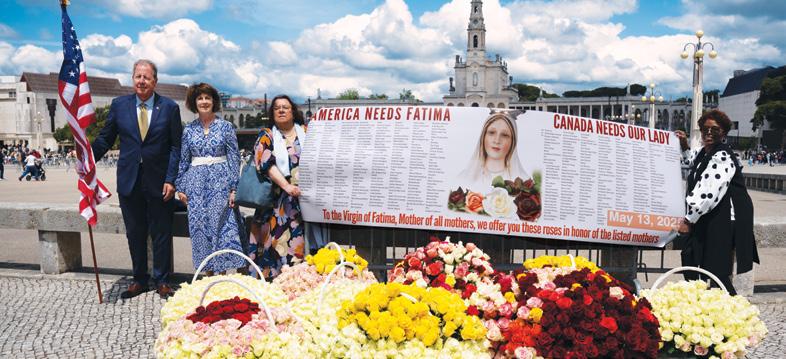
and a special membership parchment with thousands of ANF member names. These were all presented at the Chapel of the Apparitions. The ANF volunteers also made sure to pray for the intentions of all ANF benefactors and members at the tombs of Saints Jacinta and Francisco of Fatima, as well as at the shrines where the Angel of Peace appeared in 1916.
Many ANF members expressly participated in this year’s Name Banner, Fatima Rose Wreath and Mother’s Day Rose Campaign not only to show Our Blessed Mother their affection, but also to honor Our Lady on behalf of their own mothers, living and deceased. Having lost my own mother recently, the presentation of roses was a moving testament to all Catholic mothers who have cared for us both materially and spiritually and taught us to love “Mama Mary” with all our hearts.


Our Blessed Mother is the best of all mothers, and as grateful children, ANF members paid generous trib ute to her during this year’s May pil grimage to Fatima. We are confident that Our Lady smiles on each America Needs Fatima member, and we pray for the grace to have greater devotion to her. For, as the great Saint Maximilian Kolbe once said, “You can never love Mary more than Jesus loved her.” n
Top: America Needs Fatima's banner contains the names of thousands of friends and supporters who made the pilgrimage in spirit. Middle: The Fatima esplanade flickers with flames during the candlelight rosary procession, May 12, 2025. Bottom: Mr. and Mrs. Bascom, volunteers of America Needs Fatima, present a white silk rosette wreath at the Chapel of the Apparitions.

B y M i C hae L G orre

Making Reparation Through the Mother of All Devotions
TFP member Norman Fulkerson sat down with author Mary Jane Zuzolo to discuss her new book, Unveiling the Sixth Station of the Cross: Reparation to the Holy Face, Mother of All Devotions. The Holy Face devotion, as Zuzolo explains, is an antidote to communism and modernism, and its preference by God to all other devotions gives it the affectionate title “Mother of All Devotions.”
Norman Fulkerson: You just published a timely book on the Holy Face devotion titled Unveiling the Sixth Station of the Cross: Reparation to the Holy Face, Mother of All Devotions. What most inspired you to write the book?
Mary Jane Zuzolo: Initially, I was struck by the extreme relevance of the Holy Face of Jesus devotion in its use as spiritual armament in the defeat of communism, now manifesting itself so blatantly in our faces through societal norms, education, government and even religion. The revelations of Our Lord to Sister Marie de Saint-Pierre, a Carmelite nun in Tours, France, specifically call out communism for its overtly anti-God foundation, but implicitly include all that seek to replace God’s immutable truth with the mere contriving of men. These ideologies are both a grave offense against God and an allowed just chastisement by Him, reminding one of the wayward Israelites as described in Psalm 81: “I let them go by the desires of their hearts; they shall walk in their own inventions.” The Israelites knew the remedy: reparation. It was requisite to “turn” God’s Face “back toward” them once again, to receive His blessing once again. The Holy Face devotion is similarly appeasement of God and
God chooses this means of reparation for the times, thus utilizing the power of God and cooperation of man, for according to Christ, iniquity has never reached such a degree, described by Him as “deep-rooted impiety and absolute incredulity.”

mercy for man via specific reparation as designed by God Himself for the modern era.
I was also perplexed by why more people didn’t know about the Holy Face devotion today, especially given its initial enormous popularity. This popularity was surely in part due to the thousands of documented miracles associated with it, performed at the hands of Venerable Leo Dupont, and referred to by Pope Blessed Pius IX as “perhaps the greatest miracle worker in Church history.”
In addition, Pope Leo XIII broke with tradition by immediately approving the devotion for the whole world in 1885, drawing great attention to it. He was the same pope who composed the Saint Michael prayer after receiving the famous vision of Satan challenging Christ and proclaiming that he could destroy the Church if given enough time and power over those under him. He began the approval process within two months after this vision, surely having an idea of the spiritual armament needed.
Related to this is Christ’s warning in the revelations about devotion to the Holy Face that the devil would do all in his power to stamp out the devotion. So, perhaps Satan had succeeded for the recent decades during which the devotion certainly fell into seeming obscurity. I wanted to do my part in its resurgence.
As I researched at a deeper level to write the book, I was especially amazed to realize the profound spirituality of the devotion, remarkably in line with that of Saint Thérèse of Lisieux and the whole of the Carmelite mystical tradition, as well as with Saint Louis de Montfort’s True Devotion to
Pope Leo XIII approved devotion to the Holy Face, pictured here, just two months after his famous vision of Satan challenging Christ for rule of the world.
Mary, the devotion being surprisingly Marian.
Saint Teresa of Ávila once appeared to Sister Marie de Saint-Pierre and revealed to her that the Holy Face devotion would be “the honor of Carmel.” This is even more remarkable, given that there have since been numerous Carmelite saints and Doctors of the Church, yet it was the Holy Face devotion, rather than these, that was to be the honor of the order. I was excited to show the reader ample evidence that this alluded in great part to the devotion’s deep spirituality.
Norman Fulkerson: Could you tell us more about the sin of blasphemy as it was related in the revelations of Our Lord to Sister Marie de Saint-Pierre? It seems that it encompasses much more than taking God’s name in vain.
Mary Jane Zuzolo: Yes, blasphemy is anything that takes from God the honor and glory due to His name. As I briefly mentioned, this includes communism and other “errors of Russia,” as Our Lady of Fatima put it—any attempt by man of usurping God’s authority, comprised by sins against His rights as prohibited in the first three commandments.
The Holy Face devotion was requested by Christ during the time just following the first French Revolution and leading into the second. It was a timely request, for the free-thinking of the day had ushered in unprecedented blasphemy. This ideology had its roots in rationalism, holding that argumentation, rather than God, was the arbiter of truth and morality. This led to modernism, proposing that truth and morality were changeable and even based on personal feeling. Post-modernisms include moral relativism, positing that there is no one truth or morality, but rather, everyone has his own. Finally, wokeism appears to be an inversion of truth and morality as preserved in moral law and the doctrine of the Faith.
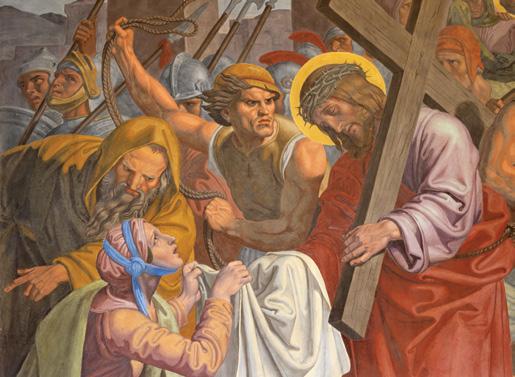
Norman Fulkerson: Your book draws a parallel between the Book of Job and the Holy Face devotion. Could you summarize some main points in that prefiguring?
Mary Jane Zuzolo: There are amazingly detailed correlations between the Book of Job and the Holy Face devotion, but most essentially, devotees of the Holy Face devotion are like both Job and his friends in that we must rely upon the merits and love residing in the wounded Face of Christ, rather than our own, in making reparation on behalf of our “friends.” God requested of the friends that they present Job’s face, with which He was more pleased, in making reparation for their own offenses against Him. Like Job’s friends, our “faces” are not worthy to make such needed reparation for the blasphemy of the times; we are to instead present Christ’s Face in place of our own. Yet, also like Job, we are required to make reparation on behalf of our “friends,” our fellow brethren, to draw graces of conversion for the multitudes. For as was also revealed at Fatima, Christ told Sister Marie de Saint-Pierre that many are going to Hell because no one is praying for them—making reparation for them. God has given us, like Job, a role to play in the salvation of our “friends.”
The offenses of the friends, and even Job’s initial offense, are the same offenses of today: the creation of our own truth and morality. The friends, in trying to “defend” God, offend Him by contorting the truth (in ignoring the innocence of Job) to fit their narrative that guilt or innocence necessarily correlates with one’s life circumstances. One is not free to create his own truth. Similarly, one is not free to decide his own morality; Job initially scrutinized God in his attempts to defend his own innocence. Man is not free to justify himself at the price of questioning God, who is the highest stand of justice. Man does not “get” to decide what is right behavior of God, nor himself. Finally, reparation must be made for these grave offenses to the majesty of God, manifest in communism and related ideologies of today.
God chooses this means of reparation for the times, thus utilizing the power of God and cooperation of man, for according to Christ, iniquity has never reached such a degree, described by Him as “deep-rooted impiety and absolute incredulity.” That is, man either doubts or rejects God and His justice to the point of inventing his own. The greatest devotion, according to Christ, is needed to repair these most heinous offenses against the Godhead, guarding against just chastisement and restoring light and life to the masses. n
TFP in Action
Fighting the good fight for moral values
Victory! Father James Martin Canceled at Holy Family University
Thanksbe to God! Fr. James Martin, S.J.—widely known for promoting views contradicting Catholic teaching—did not speak at Holy Family University’s 2025 commencement ceremony. What seemed inevitable was stopped in its tracks, and TFP Student Action played a key role in this victory for moral values and the Catholic Faith.
What Happened?
When Holy Family University (HFU) in Newtown, Pa., announced that Fr. James Martin, S.J., would receive an honorary degree and deliver a keynote commencement address on May 17, 2025, faithful Catholics were stunned— and then mobilized.
TFP Student Action launched an online petition urging HFU to disinvite Father Martin. The campaign quickly caught fire, garnering 11,132 signatures from concerned students, parents and alumni. In addition, TFP Student Action announced its intent to hold a peaceful protest outside the university if the scandalous invitation was not rescinded.
Shortly thereafter, Father Martin’s name quietly disappeared from the


list of speakers. The university did not give a public explanation, but the message was clear: faithful Catholics made a difference.
Who Is the Rainbow Jesuit?
To some, protesting a Catholic priest speaking at a Catholic university may seem odd. However, Father James Martin’s track record reveals why such action was not only appropriate but also necessary. His public support for positions in direct conflict with Catholic teaching is well documented.
For example:
Father Martin supports transgenderism for children;
He said Catholics should “reverence” homosexual unions;
He favors homosexual kissing during Mass (sacrilege);
He was featured in The New York Times “blessing” a homosexual pair;
Father Martin promoted a “rainbow rosary.”
These sinful actions do not reflect the fidelity expected from a priest— or a Catholic university’s commencement speaker.
Victory Rosary
When news broke that Father Martin was no longer speaking, the originally planned protest outside HFU turned into a rosary rally of thanksgiving.
TFP Student Action volunteers, joined by faithful local Catholics and Holy Family alumni, gathered in front
of the campus. They unfurled banners, including one that read: “Thank God, the Rainbow Jesuit Fr. Martin is NOT Speaking at HFU Today.”
Marian hymns rang out on bagpipes, and the recitation of the Holy Rosary joyfully gave public witness to the Faith. Campus security initially allowed the group to stay, but soon reversed course and asked them to leave, failing to clarify where they could legally assemble. However, a police officer intervened and pointed out a nearby public area.
Undeterred, the faithful processed down the road, with TFP bagpipers leading the way. Many drivers arriving for the commencement honked in support, and a group of religious sisters in habit joyfully waved, expressing their approval. A few dissenters hurled vulgarities, but their opposition only confirmed the need for courageous Catholic witness.
Honoring the Holy Family
Holy Family University bears a sacred name. Its patrons—Jesus, Mary and Joseph—are the perfect models for family life rooted in purity, obedience and fidelity to God’s law.
The so-called “rainbow movement,” as promoted by Father James Martin, contradicts this model. It confuses charity with affirmation of sin and seeks to normalize vice under the guise of compassion.
By canceling Father Martin’s speech, Holy Family University avoided scandal and aligned more closely with the holy example of its namesake.
What Comes Next?
Let this victory encourage every young Catholic to stand firm in the Faith. Moral relativism may be loud, but the voice of truth—rooted in tradition, reason and the Gospel—cannot be silenced.
TFP Student Action will continue defending the honor of the Church, the angelic virtue of purity and the sanctity of the family.
We thank every one of the 11,132 people who signed the petition. This is your victory, too.
Saint Joseph, Protector of the Holy Family and Terror of Demons, pray for us! n
A humble plea made to one who should be guarding his flock from the errors he himself is promoting.

bagpipes a weapon of war rather than a musical instrument. The Scots used the pipes to raise the morale in battle, whereas TFP fights in the realm of ideas. In this spiritual combat, the bagpipes boost the morale of all good people who fight for moral values in the public forum.
The bagpipes strike fear in the enemies of truth. Leftists dread them every time they sound on a liberal college campus. As one George Washington University student confessed in a letter to the editor of the GW Hatchet, “Walking to class on Thursday afternoon, I suddenly heard bagpipes and saw the dreaded red sashes.”
Leftists and pro-LGBT activists in California accused the TFP bagpipes of being “horns of hate.”
The Skirl of the Bagpipes Stirs the Soul
The sound of the bagpipes stirs something deep within the soul. It inspires awe and touches on the metaphysical and sublime. For centuries, the bagpipes have inspired admiration on battlefields, royal parade grounds, coronation ceremonies and funeral processions.
When TFP bagpipers play at the March for Life, crowds cheer joyfully. At times, even those who support the sin of abortion begrudgingly confess that the bagpipes “are indeed beautiful.” The beauty of bagpipes adds a note of sublimity to TFP campaigns and raises the soul to a realm of higher ideals.
One TFP Student Action follower said:
“The bagpipes gave solace to the men on the beaches of Normandy and, in a similar fashion,
(Continued from back cover. . . )
give solace and promote kinship to all who support your work on college campuses. Don’t ever stop playing those bagpipes. What a beautiful sound to hear in association with standing for the principles of God.”
Just as the bagpipes served for centuries as a beautiful instrument of war, TFP members play them to win the spiritual crusade of our time to restore Christian civilization.
Bagpipe Music Silences Foul Insults
There are two practical reasons to use bagpipes in a campaign: they drown out the filthy insults and attract people to a noble cause.
When liberals become particularly angry and spew foul language and vulgar insults, the bagpipes can clear the air of verbal abuse and deter leftist aggressors. However, many who hear the pipes at a distance will follow the music until they meet the TFP volunteers. Thus, the bagpipes carry and multiply the effect of the TFP campaign and help reach more people in the crusade for moral values.
Bagpiping for the Glory of God
Whatever a Catholic does is ultimately for the greater glory of God. Thus, the most important reason TFP Student Action volunteers play the bagpipes is for God, the Blessed Mother and the angels in Heaven. By adding beauty to the campaign and attracting more souls to the truth, the bagpipers serve God.
Is there a better reason to play the bagpipes?
Just as the bagpipes served for centuries as a beautiful instrument of war, TFP members play them to win the spiritual crusade of our time to restore Christian civilization. n
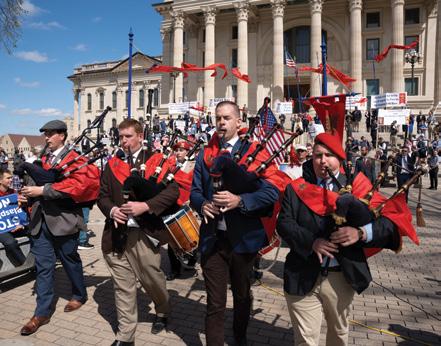
Bagpipers make a bold statement within America's major cities during campaigns held nationwide.
Bagpipes were effective in the fight against Satanism at the steps of the Kansas State Capitol, where Satanists held a Black Mass on March 28, 2025.
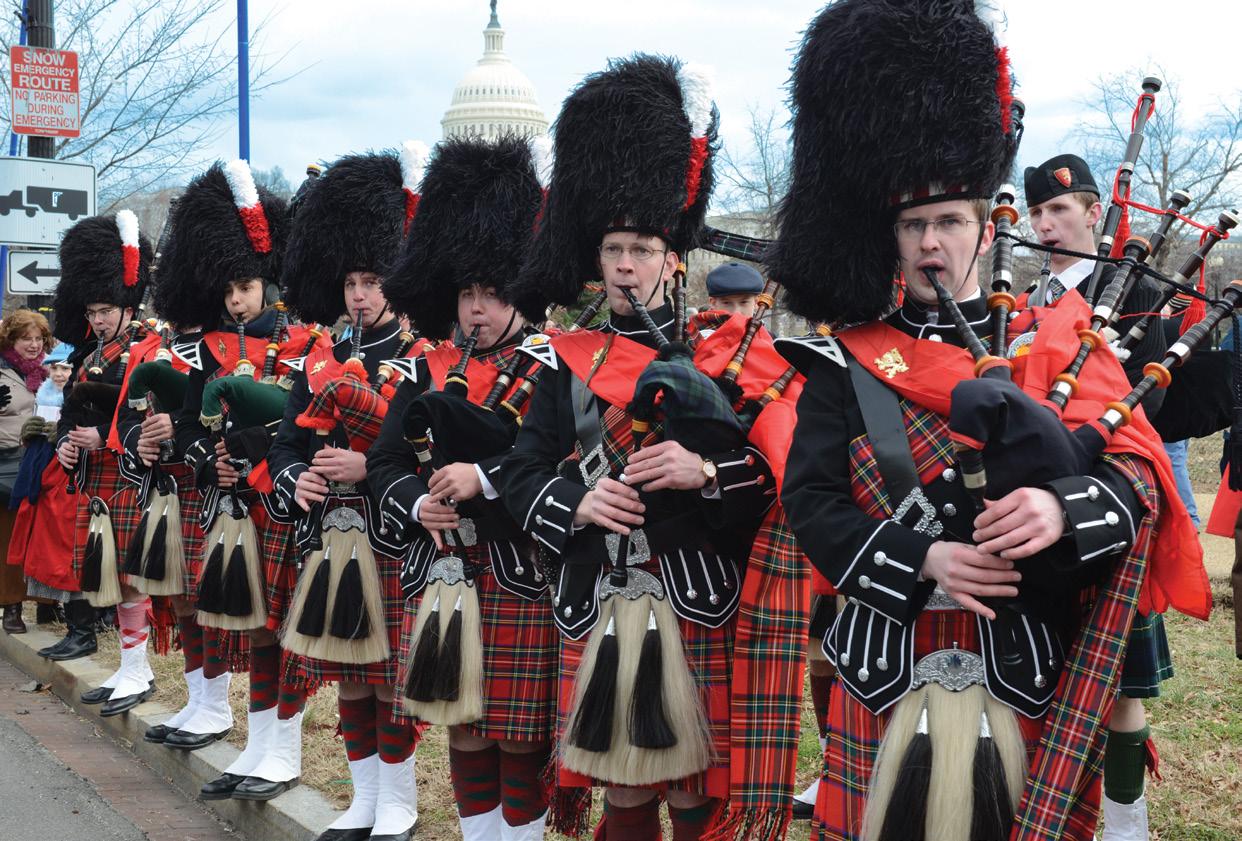
Why Liberals Hate TFP Bagpipes, but Others Love Them
Why does The American Society for the Defense of Tradition, Family and Property (TFP) use bagpipes at its events? Over the last two decades, TFP Student Action has become well known for its epic campaigns with red capes, large red standards with golden lions and bagpipes. The iconic TFP bagpipers are recognizable by conservatives and liberals at street campaigns, university campuses and rosary rallies.
The “war pipes” are highly visible and audible in the crusade for traditional family values, especially at the national March for Life in Washington, D.C.
Nevertheless, many people want to know, “Why the bagpipes?” TFP supporters who enjoy them often pose this question. At the same time, critics, typically leftists on campuses, attempt to discredit them by complaining about the “noise,” even when they make a significant amount of unpleasant noise themselves.
How TFP Adopted the Bagpipes
In the seventies, the Great Highland bagpipes became a part of TFP events, with a bagpiper performing at TFP conferences. The tradition of using bagpipes for public demonstrations dates back to the eighties and eventually extended to annual events like the March for Life in Washington, D.C.
By 2003, the impact of a TFP bagpiper’s performance at Penn State University led to bagpipes being included in nearly every campus campaign.
TFPs abroad and sister organizations saw the positive effect of this innovation and adopted the bagpipes as a counter-revolutionary tool. Now, the rousing skirl of TFP bagpipers can be heard in Canada, Brazil, Ireland, France, Germany, Holland, Italy, Poland and Australia.
Liberals Call Them “Horns of Hate”
Until 1996, the British government considered the
(Continued on page 23.
TFP bagpipers at the annual March for Life in Washington, D.C.
